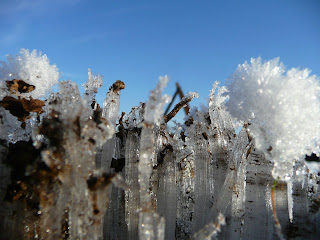
I took my tractor to the shop and had the steering and tire toe-in adjusted, welded a few cracks on the fender moved the front wheels in closer and freed up the brake pedals (both pedals were seized to the shaft so I could not brake only the left or only the right tire). The Kubota drives much easier and the tin rattling from the fender is repaired and then I damaged the fender again while backing into a heavy thicket of blackberry vines.
I decided that since the soil dried out temporarily I would try to mow more blackberries. The patch that I was about to tackle was even more difficult because somewhere in that thorny mess a woven wire fence was tangled by vines. I carefully lifted the loader high above head, drove into the berries as to not poke a rigid cane through the radiator and then lowered the bucket onto the thorns and pulled them down and back as I went in reverse. This pushed the blackberries low to the ground so that I could then back over them with the brush cutter mounted to the back of the tractor. I repeated this process until I could see the fence through the debris on both sides of the fence line.
I then attached a chain to the front of the bucket and lifted the old bent and rusted T-posts out of the muck by attaching the other end of the chain to the post and lifting the loader straight up above the fence line. It worked perfectly and with all of the posts removed I safely pushed the fence with the tractor until I was dragging enough wire on either side of the machine that my tires were about to get tangled. I put it in reverse and repeat the procedure fifty feet down the line.
Now with that cross fence removed and the brush mowed I will be able to acess the bottom of the field wherever it is the driest. I will constantly be mapping where the field becomes the wettest and where it dries out the quickest. This will determine where future crops, animals and structures go.



































.JPG)






.JPG)



 Visions of a barn, equipment shed, market stand and garage dance in our heads, but the cost of materials slows down construction considerably. So for now, our curing garlic shares a space with the bikes while chicken feed hides among tools, lawnmowers, and other odds and ends that belong in a storage shed.
Visions of a barn, equipment shed, market stand and garage dance in our heads, but the cost of materials slows down construction considerably. So for now, our curing garlic shares a space with the bikes while chicken feed hides among tools, lawnmowers, and other odds and ends that belong in a storage shed. 



.JPG)
